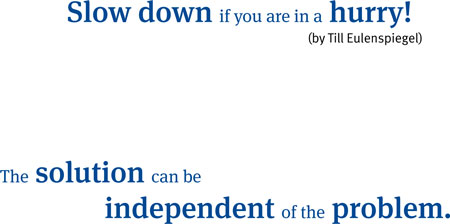Abschnitt 5 - 5 Tips for moderating
the brainstorming meetings
Reason
Agreement on changes - The reason for moderating is to analyse the actual situation and agree on changes.
Aim
Joint solution - The aim of moderating is to find a joint solution that everyone involved can agree on. This creates the willingness for implementation.
Components
Openness - Approach the task of moderation with an open attitude. Should you have a preferred solution for solving the problem, abstain from this during moderating or transfer the moderation to a colleague.
Appreciation - Appreciate the opportunity to find a joint solution as well as the attendees who take the time and contribute their perspective.
Deceleration & listening - Many problems arise from not listening correctly and thinking that we can anticipate what others want to say. Listen actively. Summarise statements of attendees and ask whether you have understood correctly. "Slow down if you are in a hurry" is a helpful rule.
Neutrality in the sense of "multi-partiality" - Take sides for each issue, see the good side of the proposal and the contribution to discussion and specify it.
Expertise - Attendees are experts with respect to problems and solutions. Solutions will be jointly developed. Your task as moderator is to pose the right (open) questions to enable participants to find the solution path.
Questions - Pose open questions. Discuss the problem with the participant, but do not linger on the issue for too long. Use open questions to help the attendees to find solutions for improvement. Please keep in mind: The solution can be independent of the problem.
In your questions, do not concentrate on the whys and wherefores! Why? Because you put the attendees in a defensive stance. Instead, ask "how" something is working.
Speaking time - Everybody should be listened to and get a chance to speak. As a moderator, you may summarise long contributions and shorten them, if agreed. Ask whether you have reproduced the essentials.
Objections - All objections must be taken seriously. Acknowledge every objection. Ask the other participants for the reasons for objection and then for an alternative how to discuss this issue.
Documentation - Document the solution path (on a flip chart or wall drawing) so that it is visible for everybody.
Consent - Before concluding with a solution, ask all persons involved whether they have further ideas or objections. And if so, listen to them.
Potential pitfalls
 | You have a solution in mind and look for fellow campaigners. |
|---|---|
 | In this case assign another person with the moderation and take part in the discussion yourself. If you are unable to assign another person with the moderation, present your solution and motifs in a transparent way - and give others the chance to discuss this issue openly. |
 | The emphasis is on evaluation and judgment, not on observing. |
 | Evaluation is viewed as judging. Persons who are evaluated negatively usually keep quiet. This is dangerous as they are not involved in finding a solution. |
 | If it does not work out initially and you are unsatisfied: |
 | Practice makes perfect. It is vital to keep trying and to make own experiences. You may also make the attendees aware of their own responsibilities. Inform them on what is important to you and ask them whether someone is willing to support you in terms of feedback or co-moderation. Accept support! |

